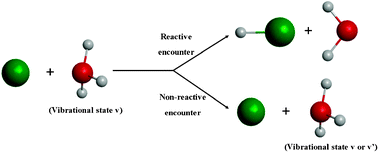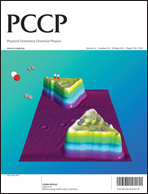Quasi-classical trajectory study of the role of vibrational and translational energy in the Cl(2P) + NH3 reaction
Abstract
A detailed state-to-state dynamics study was performed to analyze the effects of vibrational excitation and translational energy on the dynamics of the Cl(2P) + NH3(v) gas-phase reaction, effects which are connected to such issues as mode selectivity and Polanyi's rules. This reaction evolves along two deep wells in the entry and exit channels. At low and high collision energies quasi-classical trajectory calculations were performed on an analytical potential energy surface previously developed by our group, together with a simplified model surface in which the reactant well is removed to analyze the influence of this well. While at high energy the independent vibrational excitation of all NH3(v) modes increases the reactivity by a factor ≈1.1–2.9 with respect to the vibrational ground-state, at low energy the opposite behaviour is found (factor ≈ 0.4–0.9). However, when the simplified model surface is used at low energy the independent vibrational excitation of all NH3(v) modes increases the reactivity, showing that the behaviour at low energies is a direct consequence of the existence of the reactant well. Moreover, we find that this reaction exhibits negligible mode selectivity, first because the independent excitation of the N–H symmetric and asymmetric stretch modes, which lie within 200 cm−1 of each other, leads to reactions with similar reaction probabilities, and second because the vibrational excitation of the reactive N–H stretch mode is only partially retained in the products. For this “late transition-state” reaction, we also find that vibrational energy is more effective in driving the reaction than an equivalent amount of energy in translation, consistent with an extension of Polanyi's rules. Finally, we find that the non-reactive events, Cl(2P)+NH3(v) → Cl(2P) + NH3(v′), lead to a great number of populated vibrational states in the NH3(v′) product, even starting from the NH3(v = 0) vibrational ground state at low energies, which is unphysical in a quantum world. This result is interpreted on the basis of non-conservation of the ZPE per mode.


 Please wait while we load your content...
Please wait while we load your content...